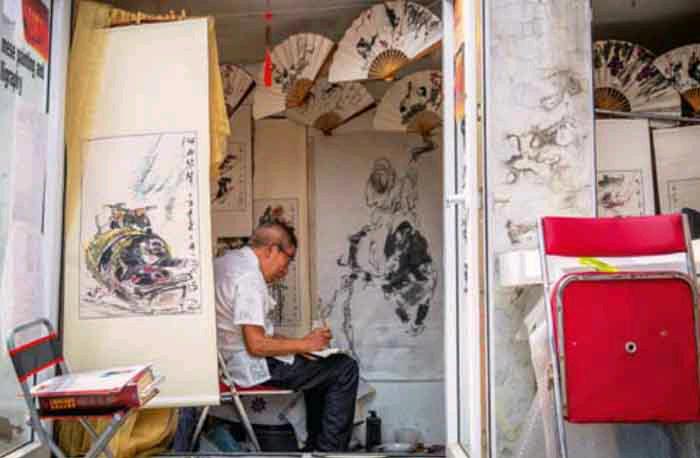Beijing’s Hutongs:City Inside a City
by+Helena+Villar+Segura
An old man parks his bicycle at a corner to buy a pack of cigarettes. While lighting a cigarette, he takes out his phone and scans the QR code of the roadside shop to pay before leaving.
A young, energetic delivery driver with a phone in hand screeches to a halt to avoid barreling into a group of giggling uniformed schoolgirls eating fruit.
Halfway down the street, a smiling woman under a huge red umbrella sells lettuce, carrots, onions, tomatoes, potatoes and many other vegetables I couldnt identify as well as local yogurt, water, ice cream, oranges, blueberries, coconuts, bananas and durians. I consider a future purchase. I love durians.
On the left I spot a cozy-looking shop. An elegant lady in white opens the glass door ringing a bell. Inside the shop every- thing is white too. The walls, table, chair, computer… even a cat! An iron, a frame, some notebooks, pens, clothes—all white—are all for sale. The only exceptions I can find are green cacti. I consider another future purchase.
Outside the shop, a little girl in split pants runs awkwardly while waving a spoon, as her grandmother follows her zigzagging steps. When the kid looks back laughing, she runs into a row of shared bicycles. “Dont cry,” I say. She does anyway, but quickly forgets about the pain when she sees ten foreigners carrying luggage down the alley.
A flash from their cameras captures a group of locals chatting and enjoying the blue sky. One neighborhood resident is going home. She turns around and enters her house with a baby. Some elderly people sitting nearby at the entrance of a courtyard youth hostel talk, eating noodles and playing Chinese chess in Beijings labyrinthine hutong (alley) area.
The first time I came to the capital of China, I had no plans to ever return. The world is such a big place that you normally dont think of visiting such a faraway city twice. This metropolis in northern China was a surprise: cosmopolitan, old and new, dotted with historical buildings, dance clubs on rooftops and people practicing Tai Chi. I wandered around the interesting city, climbed the Great Wall on its greenest days and let the magnificence of the Forbidden City consume me. I boated at the Summer Palace, took pictures of the Temple of Heaven and rode the metro to Yonghegong Lama Temple. I saw prayer flags in downtown Beijing. Tour guides explained even more about the splendid culture.endprint

Five minutes from many modern metro stations in downtown areas are neighborhoods of narrow alleys, which not only remain home for people from Beijing who have been living there for generations, but also welcome new residents including foreigners, fancy restaurants, traditional tea shops, public restrooms, dumpling vendors and bars. Chaos exists alongside the cozy life.
A hutong area is a city inside a city—a community secluded from the rest of the capital but located right in the center of it. I fell in love with such alleys. They are the resulting streets serving adjacent lines of courtyard residences, one after another, like a maze. They were first built during the Yuan Dynasty (1271-1368), and many more emerged in the subsequent Ming(1368-1644) and Qing (1644-1911) dynasties. “Hutong,” in fact, is a Mongolian word that means water-well, since most of those areas were designed around a well where locals could get water for daily activities. When the Forbidden City was built in the early 15th Century, it was already surrounded by lanes of courtyards, divided by social class. High-ranking officials and powerful merchants generally owned the largest courtyards. The furthest courtyards from the city center were smaller and more modest and belonged to artisans, workers and merchants. Some of the twisted lanes remain in the city today, and I discovered them on my very first trip to China.
Now, nearly five years later, I live in Beijing. Every time someone visits me, I take my guest to every well-known spot I can find. But when I am alone, I just stroll through the most authentic lanes of the city. A feeling of calm lingers. Somehow time slows down in those neighborhoods. Some days I eat food from Singapore, and other days I enjoy Yunnan cuisine served in a yard. If a good friend visits, we may have a leg of lamb cooked over burning coal and eat it on the street, or take a walk at night when everything is closed. Most of the time, I spend my afternoons in a Tibetan-style restaurant or a coffee shop that plays Spanish guitar music, where I read or study. Outside the window grandmas, children, cleaning carts and residents stroll around. Beautiful sunsets glow when the weather is good. I enjoy all of them. In a few years, perhaps I wont be here. I already predict missing it, and all it will be is some pictures and my fading memory of it. Thats why I keep my camera at hand at all times and a notebook and pen close by. endprint
endprint
China Pictorial2017年10期
